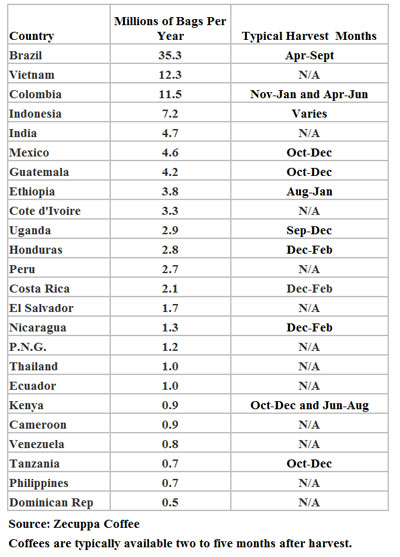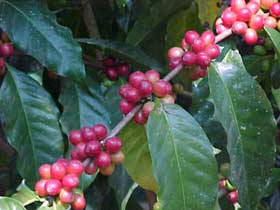Glossary:AA Acidity Acrid Affogato After Dinner Roast Aftertaste Aged Coffee Air Roaster Alkaline Altura Altura Coatepec American Roast Americano Antestia Arabian Mocha Arabica Aroma Artisan Coffee Arusha Ashy Aspiration Astringent Baggy Baked Balance Bani Bar Bar System Barista Batch Roaster Bean Probe Bean Temperature Beneficio Bird Friendly Biscotti Bits Bitter Black and White Black Beans Black Eye Black Russian Blade Grinder Blend Blotchy Blue Mountain Boat Shaped Body Boiler Bouquet Bourbon Bourbon Santos Brazil Bready Breve Brewing Bright Briny Bugisu Bullhead Burr Grinder Cafe Cafe au Lait Cafe Bonbon Cafe Noisette Caffe Caffeine Cappuccino Caramelly Carbony Caturra CBB Damaged Chaff Chiapas Chicory Chipinge Chocolatey Cinnamon Roast Citrus City Roast Clean Coatepec Coffea Canephora Coffee Berry Borer Coffee Cherry Coffee Fest Coffee Future Coffee Kids Coffee Leaf Rust Colombia Complexity Costa Rica Crema Crushed Crust Cultivar Current Crop Cyclone Separator Dark Roast Decaffeinated Demitasse Diseased Dominican Republic Doppio Dose Doser Doser Grinder Double Drip Coffee Drip Tray Drought Affected Drum Roaster Dry Dry Process Earthy El Salvador Elephant Beans Espresso Espresso con Panna Espresso Granita Espresso Machine Espresso Pod Espresso Romano Estate Ethiopia Ethiopia Harar Ethiopia Sidamo Ethiopia Yirgachefe Excelso Faded Fair Trade Fazenda Ferment Filter Basket First Crack Flat Flavored Coffee Floaters Floral Foxy French Press French Roast Freshness Frothing Fruity Gelato Gicleur Gourmet Coffee Grade Grande Grassy Green Coffee Grind Grounds for Health Group Guatemala Guatemala Antigua Guatemala Coban Guatemala Huehuetenango Half Caf Hard Bean Harmless Harsh Harvest Machine Harvesting Hawaii Herbal Hidey Honduras Hulling Iced Latte Iced Mocha ICO India India Monsoon Indonesia Instant taste Irish Coffee Italian Roast Jamaica Java Kenya Knock Box KVW Latte Latte Art Macchiato Malty Medicinal Medium Roast Mellow Methyl Chloride Mexico Mocha Java Mocha Latte Moldy Monsooned Mottled Musty Neutral New Crop Nicaragua No Fun Nose Nutty Oniony Organic Outer Skin Over Fermented Pales Papery Papua New Guinea Parchment Parchment Coffee Past Crop Peaberry Peasy Peru Piston Espresso Machine Porta-Filter Primary tastes Processed Coffee Pulled Long Pulled Short Pulp Pulper Nipped Pulping Pyrolysis Quad Quaker Quakery Ragged Rancid Red Eye Ripe Coffee Roast Master Robusta Rubbery Rwanda SCAA Scorched Second Crack Semi Dry Process Shell Shot Silver Skin Single Origin Skinny Smooth Solo Sorting Sour Spicey Spot Price Steam Wand Steaming Pitcher Stinker Strictly Hard Bean Strictly Soft Bean Sulawesi Sumatra Supremo Swiss Water Process Taint Tall Tamper Tamping Tanzania Tobacco Turkish Coffee Uganda Under Dried Utz Certified Valve Bag Varietal Vente Vienna Roast Vietnam Water Purification Water Softening Wet Wet Mill Wet Process Whole Bean Winey With Legs Withered Woody Yemen Zimbabwe Coffee Glossary Categories:Drinks & Recipes Brewing Classification & Grading Bean Defects Plant Varieties Producing Countries Cupping & Tasting Farming & Processing Organizations & Certifications Roasting Coffees by Origin |
. |
Coffee Terms - Glossary of Coffee Terminology.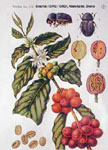 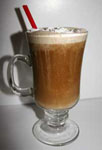 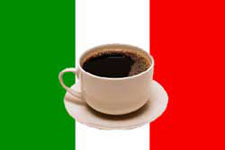 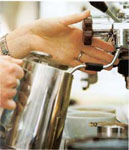 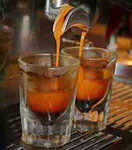 From farming and processing terms, to coffee roasting and Barista lingo, you can find it here.
Coffea plants are native to Ethiopia, where they still grow wild in the Southwestern Highlands of the Kaffa and Buno districts. The beginning of the coffee industry is unclear, but coffee became a commodity sometime before 1500. Coffea
plants produce cherries
normally having two seed halves known as coffee beans. Coffea
trees grow to 40 feet high, but are normally pruned by
farmers to a manageable height. There are two commercially
available coffea species, Robusta and Arabica. Robusta is more
"robust", due to a
natural resistance to disease and infestation. Both species grow well
between the Tropic of Cancer and the Tropic of Capricorn. Arabica beans
are highly regarded as having the best flavor.
Arabica plants are mostly grown at higher elevations where temperatures
and rainfall are fairly consistent, and where there are fewer insects.
Because of the steep terrain where Arabica is typically grown,
harvesting is normally done by
hand. Ripe coffee cherries are harvested and processed various ways to remove the skin, pulp, and parchment (husk). The husks of the dried seeds are removed to expose the "coffee beans". At low altitudes, where the land is generally flat, coffea cherries are easily harvested by machine. There are three distinctly different coffee processing methods; wet process, dry process, and semi-dry process. The first commercially harvested Coffea plant was Typica Arabica, followed by Bourbon Arabica and Robusta. Robusta replaced many Arabica plantations as they were ruined by Rust Disease. Today there are more resistant and higher yielding Arabica varieties slowly replacing the classic Typica and Bourbon varieties.
There is currently no widely adopted standard for grading coffee. The SCAA has a detailed standard for bean classification, but world wide implementation of the SCAA standard is minimal. In general, the predominant method of grading coffee is by green bean size, followed by the number of defects in a sample. Brokers and roasters maintain quality by identifying defects, cupping new lots, and by buying from consistent and reputable suppliers. See Classification and Grading for related coffee information.
The coffee bean undergoes many processes. From the beginning as a seed
to the time the coffee is roasted, there is opportunity for defects.
Major causes of defects are
weather, insects, disease, improper husbandry, and imperfect
processing. A small percentage of defects can be found in any bag of
coffee. High quality sourcing and inspection, along with cupping and
tasting, is the conventional method of finding premium coffees for the
more profitable specialty market. The number of coffee bean
defects in a coffee sample is generally part of coffee classification and
grading.
Barista and Brewing Terminology In the 1960s, coffee consumption in the United States appeared to have peaked, even though it was mostly poor quality canned Robusta. In the early 1970s, US consumption was in decline, but things changed when Mr Coffee, an automatic drip brewer, was introduced. The early 1980s brought Italian espresso machines and an espresso coffee culture that is still growing and evolving. Much of the terminology used to in the coffee industry has its roots in Italy, and to a lesser extent France.
The basic steps of cupping are: smell the freshly grounds; mix two tablespoons of medium ground coffee with six ounces of hot water and let sit for three minutes; break (agitate) the crust with your nose directly above the glass to sample the aroma; taste while still hot with a heavy slurping action to cover the tongue; Retaste when lukewarm; note the flavors, aroma, body, and aftertastes. Cuppers generally rinse their mouth with water to help clear away tastes previous samples. Many coffee tastes are difficult for most to detect and flavor differences between coffee varieties are usually subtle. Flavors vary by origin, but also by roast, freshness, and type of processing. Tasting and cupping may be done to detect defects, to insure consistency, and before purchasing a large quantity. See Cupping and Tasting coffee glossary. Flavored syrups are typically added to milk based espresso drinks (e.g. double tall chocolate caramel cappuccino). Flavored coffees, on the other hand, are flavored after roasting and before grinding, and are generally made from the lowest grade beans. When placing
an order at an espresso bar, say the number of shots,
drink size, then drink style and name, followed by any other request.
The following are examples of espresso drinks: Double Tall Decaf Latte,
Quad Vente Iced White Mocha, Single Tall Why
Bother with Room, Triple Tall Dry Cappuccino, Short Non-Fat Sugar Free
Vanilla Latte, Single Short Decaf Americano, Quad Vente Caramel
Macchiato. See Brewing and Preparing
coffee glossary for more barista lingo.
There are many organizations
related to coffee. The most influential worldwide
and in United States are the ICO and SCAA. Both are trade organizations
dedicated to quality and sustainability of coffee production, and to
the coffee industry as a whole. The ICO is the main intergovernmental
organization that facilitates international cooperation in support of
the worlds coffee market. Many smaller coffee organizations are focused
narrowly on the environment and/or conditions for families
involved in the coffee export business.
Coffee Roasting Terminology Since the 1500s, possibly earlier, coffea plant seeds were being heated to make coffee beverages. Since then, coffee has risen to become the world's most popular beverage. Although the coffee beans are dried during processing,
their moisture content is still about 11%. In order to reach the
temperatures necessary for flavor development, the beans must reach
temperatures above 370F, roughly the temperature at which sugars begin
caramelizing. Much of the time required to roast a batch of beans is spent
boiling off moisture. The actual roasting process
is short (several minutes), and to prevent baking, the roasted
beans cooled rapidly (5 minutes or less). There are two periods
of cracking sounds during a roast, "first crack" and "second
crack". The temperatures where the first and second cracks begin and end varies
by type of bean and type of roaster. "First crack" typically begins
at a bean surface temperature of 400 degrees Fahrenheit, when beans
suddenly expand, making a sound similar to popcorn. At bean probe
temperatures around 440 to 450 degrees Fahrenheit, the first crack has
usually ended and a series of more intense crackling sounds, called
"second crack" can be heard. If the roast is ended at the beginning of
first crack, the coffee will taste under-roasted. Roasts
brought to the beginning of second crack will be between
medium and dark. Second crack is where the realm of dark roasts begins
and where roasty flavors are created. See Roasting for related coffee information. Gourmet Arabica is typically identified by origin. High grown Arabica varieties have the most demand and fetch the highest prices. There are hundreds of coffee growing regions, but only about a couple dozen are widely known for consistently producing large quantities of specialty grade Arabica. With a few exceptions, the best coffees are harvested in remote mountainous regions not too far from the equator. The bulk of the world's Arabica is produced in mountainous areas of Central and South America, followed by the highlands of Indonesia and eastern Africa. Most islands do not have the combination of high altitude and ideal climate necessary for specialty grade Arabica. A notable exception is Jamaica's Blue Mountain and the slopes of Mauna Loa and Mauna Kea on the island of Hawaii. |
||||

